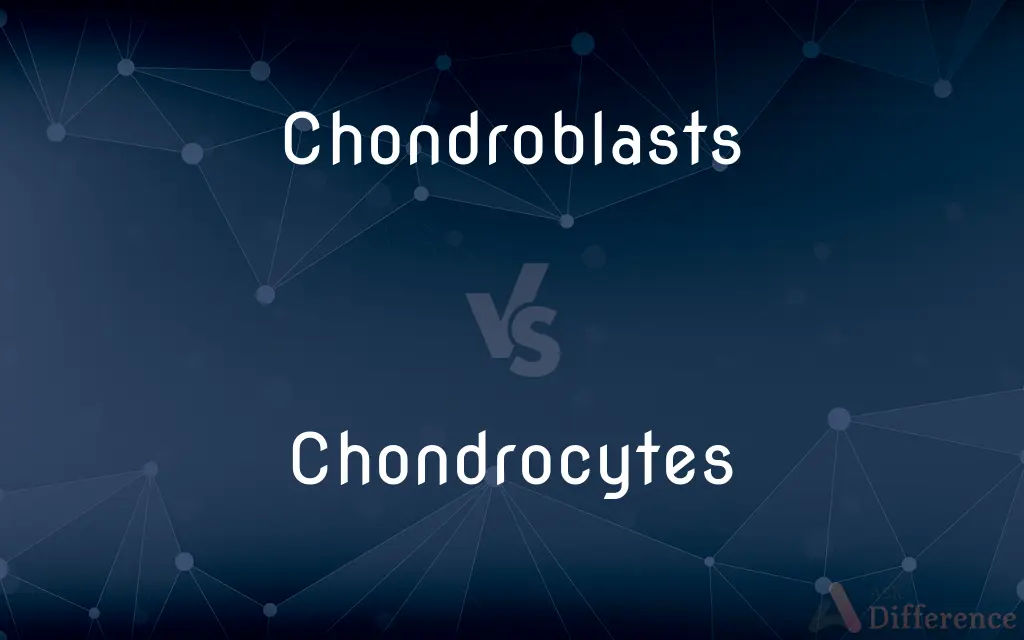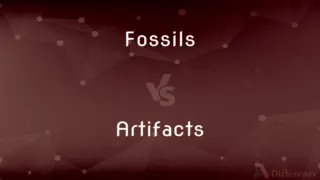Chondroblasts vs. Chondrocytes — What's the Difference?
By Tayyaba Rehman — Published on November 17, 2023
Chondroblasts are cells that produce cartilage matrix, while Chondrocytes are mature cells embedded in the matrix, maintaining cartilage.

Difference Between Chondroblasts and Chondrocytes
Table of Contents
ADVERTISEMENT
Key Differences
Chondroblasts and Chondrocytes both play pivotal roles in cartilage formation and maintenance. Chondroblasts are responsible for synthesizing the extracellular matrix and cartilage. In contrast, Chondrocytes are the mature form that reside within the matrix.
Chondroblasts are generally found at the periphery of growing cartilage, where they help in cartilage growth by secreting matrix. On the other hand, Chondrocytes are present within the lacunae of the cartilage, ensuring its health and resilience.
The transition from Chondroblasts to Chondrocytes marks a shift from an active matrix-producing phase to a phase where the primary function is maintaining the cartilage. Chondrocytes are essentially Chondroblasts that have been trapped within the matrix they produced.
Chondroblasts and Chondrocytes are crucial for our skeletal system. Chondroblasts, through matrix production, give rise to the cartilage framework. Chondrocytes, once settled in the matrix, help in cartilage's sustenance and longevity.
Both Chondroblasts and Chondrocytes can be found in various cartilage types in our body. They ensure that our joints remain lubricated, and our skeletal structure remains strong. Without their symbiotic relationship, cartilage health would be compromised.
ADVERTISEMENT
Comparison Chart
Function
Produce cartilage matrix.
Maintain cartilage once formed.
Location
Found at the periphery of growing cartilage.
Reside within the lacunae of the cartilage.
Maturity
Immature cartilage cells.
Mature cartilage cells.
Activity Level
Highly active in matrix production.
Less active, primarily maintaining the matrix.
Appearance
Not embedded in the matrix.
Embedded in the cartilage matrix.
Compare with Definitions
Chondroblasts
Chondroblasts are precursor cells that give rise to Chondrocytes.
Once Chondroblasts become entrapped in the matrix, they mature into Chondrocytes.
Chondrocytes
Chondrocytes have a primary function of maintaining the health and resilience of cartilage.
Unlike Chondroblasts, Chondrocytes focus on cartilage maintenance.
Chondroblasts
Chondroblasts actively participate in cartilage formation through matrix synthesis.
Chondroblasts play a primary role in the early stages of cartilage development.
Chondrocytes
Chondrocytes are mature cartilage cells found within the cartilage matrix.
Chondrocytes reside in tiny spaces known as lacunae within the cartilage.
Chondroblasts
Chondroblasts are typically found at the outer regions of cartilage structures.
In growing cartilage, Chondroblasts can be observed along the periphery.
Chondrocytes
Chondrocytes evolve from Chondroblasts once they become embedded in the matrix.
The matrix-produced Chondroblasts ultimately become Chondrocytes.
Chondroblasts
Chondroblasts, once they cease matrix production and become encased, transition into Chondrocytes.
As Chondroblasts finalize their matrix secretion, they transform into Chondrocytes.
Chondrocytes
Chondrocytes ensure that the cartilage remains robust and functional.
The longevity of our cartilage is ensured by the diligent work of Chondrocytes.
Chondroblasts
Chondroblasts are immature cartilage cells responsible for producing the cartilage matrix.
The Chondroblasts secrete the substances needed for cartilage formation.
Chondrocytes
Chondrocytes are integral to the sustenance and repair mechanisms of cartilage tissue.
In damaged cartilage, Chondrocytes become active to initiate repair.
Chondroblasts
Plural of chondroblast
Chondrocytes
Plural of chondrocyte
Common Curiosities
What are Chondroblasts?
Chondroblasts are immature cartilage cells that produce the cartilage matrix.
How are Chondrocytes different from Chondroblasts?
Chondrocytes are mature cartilage cells embedded in the matrix, while Chondroblasts produce the matrix.
Where can Chondroblasts typically be found?
Chondroblasts are found at the periphery of growing cartilage.
What is the primary function of Chondrocytes?
Chondrocytes maintain the health and integrity of cartilage once formed.
How do Chondroblasts transition to Chondrocytes?
Chondroblasts become Chondrocytes when they get trapped in the matrix they produce.
Do Chondrocytes multiply within the cartilage matrix?
Chondrocytes can divide, but at a slower rate, especially in mature cartilage.
Are both Chondroblasts and Chondrocytes essential for cartilage?
Yes, Chondroblasts produce the matrix, and Chondrocytes maintain it.
Is the activity level of Chondroblasts higher than Chondrocytes?
Yes, Chondroblasts are more active in producing matrix, while Chondrocytes focus on maintenance.
What role do Chondroblasts play in cartilage injuries?
Chondroblasts actively produce matrix to aid in cartilage repair when there's an injury.
Can Chondrocytes revert back to Chondroblasts?
Typically, Chondrocytes do not revert to Chondroblasts. They remain in the matrix maintaining cartilage.
What's the significance of Chondroblasts in developmental biology?
Chondroblasts are crucial in early skeletal formation during embryonic development.
Can Chondroblasts and Chondrocytes be artificially cultured?
Yes, both cells can be cultured in labs, often for research or therapeutic purposes.
Do Chondroblasts have a lifespan?
Yes, like all cells, Chondroblasts have a lifespan, but they transition to Chondrocytes as they mature.
What happens to cartilage if there's a deficiency of Chondrocytes?
A deficiency of Chondrocytes can compromise the health and repair mechanisms of cartilage.
Share Your Discovery

Previous Comparison
Ice-cream vs. Sundae
Next Comparison
Fossils vs. ArtifactsAuthor Spotlight
Written by
Tayyaba RehmanTayyaba Rehman is a distinguished writer, currently serving as a primary contributor to askdifference.com. As a researcher in semantics and etymology, Tayyaba's passion for the complexity of languages and their distinctions has found a perfect home on the platform. Tayyaba delves into the intricacies of language, distinguishing between commonly confused words and phrases, thereby providing clarity for readers worldwide.












































